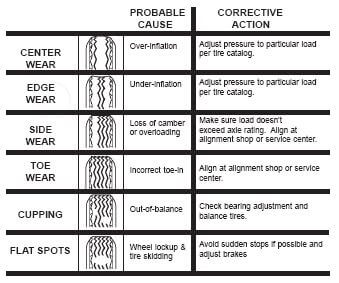Identifying Tread Wear Problems
Identifying Trailer Tire Tread Wear and its Causes

Think about the most important part of your vehicle—what comes to mind? For most people, the most important parts of their vehicle exist under the hood… but that’s because we often forget about just how important our tires are!
When it comes to trailers, the same argument can be made: trailer tires are the most important part of the trailer itself because they allow you to safely and effectively transport your cargo from Point A to Point B. And, like the tires on your car, truck or SUV, they’re subject to wear and tear as you ramble down the road. It’s important to identify these types of tread wear to prevent costly blowouts and damage to your trailer while on the road:
- Normal tread wear: Normal tread wear is easy enough to spot by looking at the tread wear indicator on your trailer tires. The indicator is a straight line that reaches from the edge of the tread to the edge of the opposite side of the tread and once it’s even with the tread itself, it’s time to replace your tires before they become a hazard.
- Wear due to over-inflation: If you’re a little overzealous when it comes to the PSI in your trailer tires, you’re bound to see signs of wear associated with over-inflation. Overinflated tires will experience wear through the center of the tread so that it appears to have a smooth strip down the center. An easy way to correct over-inflation wear is to let some air out of your tires.
- Wear due to under-inflation: If you’re lacking in tire pressure on your trailer tires, it’s going to show via wear on the inside and outside edges of the tire. The center of your tire tread will remain in good condition, but will be marred on both sides by wear that can easily be corrected with a little extra PSI, to bring your tires back up to their ideal pressure level.
- Feathered wear: Feathered wear occurs on half of your trailer tire and is the product of unbalanced toe alignment. Too much toe in or out will put stress on half the tire and leave it looking worse for the wear, while the other half looks close to brand new—it’s easily resolved with a proper alignment.
- Camber wear: Another type of wear that affects half of your tread, camber wear can be the result of an alignment issue or an overloading situation. Camber wear makes your tire look slanted. If lightening your load doesn’t resolve the issue, consider having an alignment done.
- Spotty wear: The cause of spotty wear is tricky to diagnose, but generally, it falls under the realm of stoppage and terrain. Wheel lockups, skidding, out-of-balance tires or uneven road conditions can cause spotty wear—avoiding sudden stops, being easy on the brakes and balancing your tires can work to slow the progress of spotty wear.
Before you hitch up your trailer for another adventure, make sure to check the condition of your tires and treads. Identifying the common types of trailer tire wear above can be the difference between getting to your destination safely and ending up on the side of the road, waiting for a tow!

